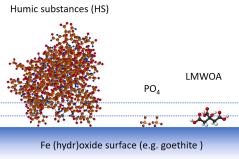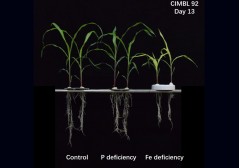
Project
Root exudate-enhanced phosphorus availability in soil
To enhance the bioavailability of the often poorly available nutrient phosphorous (P) , plants can exude low molecular weight organic acids (LMWOAs). How the effectiveness of these LMWOAs in increasing P bioavailability by desorbing P from metal hydroxide surfaces depends on soil conditions is still poorly understood. In this project we examine how natural organic matter (NOM) and soil solution conditions affect the efficiency of LMWOA in desorbing phosphate from oxides using experimental and modelling approaches.
Background
Phosphorus (P) is an essential macronutrient for plant growth. However, bioavailable P in soils is often limited because P is strongly adsorbed onto soil metal (hydr)oxides. Release of root exudates, especially low molecular weight organic acids (LMWOA), is a key strategy of plants to enhance P uptake. In soils, the omnipresent natural organic matter (NOM) will compete strongly with both LMWOA and P in their adsorption to oxides. In addition, variable soil solution conditions, such as pH, ionic strength (IS), and Ca concentration, can also affect the release of P by LMWOA. However, knowledge regarding the interactions among LMWOA, NOM and P at oxide surfaces under varying solution conditions is still very limited.
Description
The current project aims to investigate the mechanisms of P mobilization by LMWOA. Experimental and surface complexation modelling approaches will be combined in this research. Firstly, through hydroponic experiments with different maize genotypes and phosphorus levels, the profiles of root exudates, especially LMWOA, as a function of growth stage and daytime will be identified. Secondly, in batch experiments with synthesized iron (hydr)oxide, purified humic substances and various LMWOAs, the interactions of these components at the surface of oxides under various soil solution conditions will be measured and characterized. Thirdly, a surface complexation model (LCD model) will be applied and parameterized based on the experimental data. The results will lead to a better understanding of the mechanisms involved in P mobilization from soils by LMWOA in root exudates as well as to more efficient P-fertilization strategies.
Results
This project has three anticipated outputs. Firstly, it aims to identify the root exudate constituents excreted by maize to enhance P uptake. Secondly, the project intends to develop a surface complexation model describing competitive adsorption between LMWOA, NOM constituents and PO4 under various environmental conditions (figure 1). Finally, the project seeks to create a simple tool for predicting the effectiveness of LMWOA at enhancing P availability depending on soil conditions.

